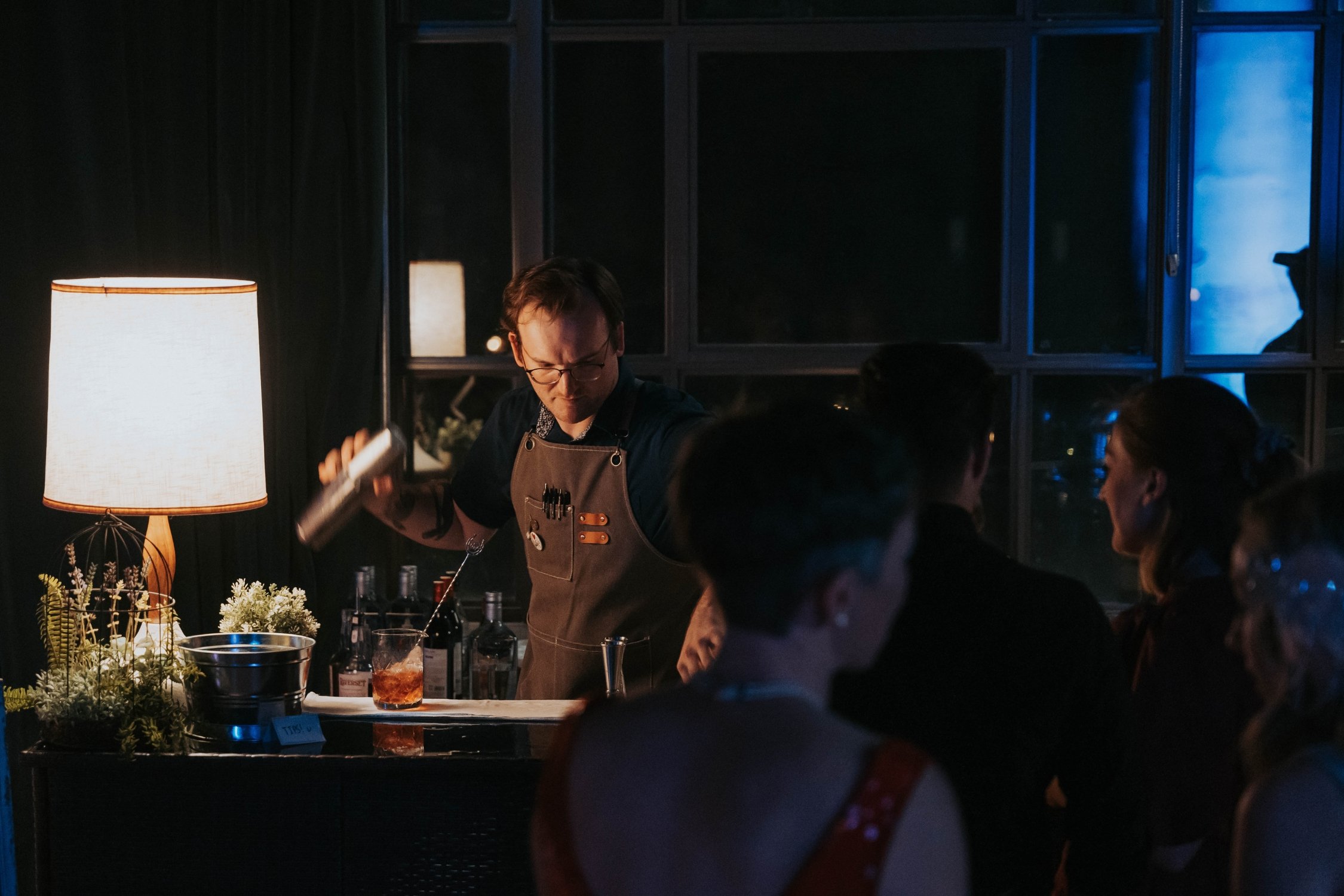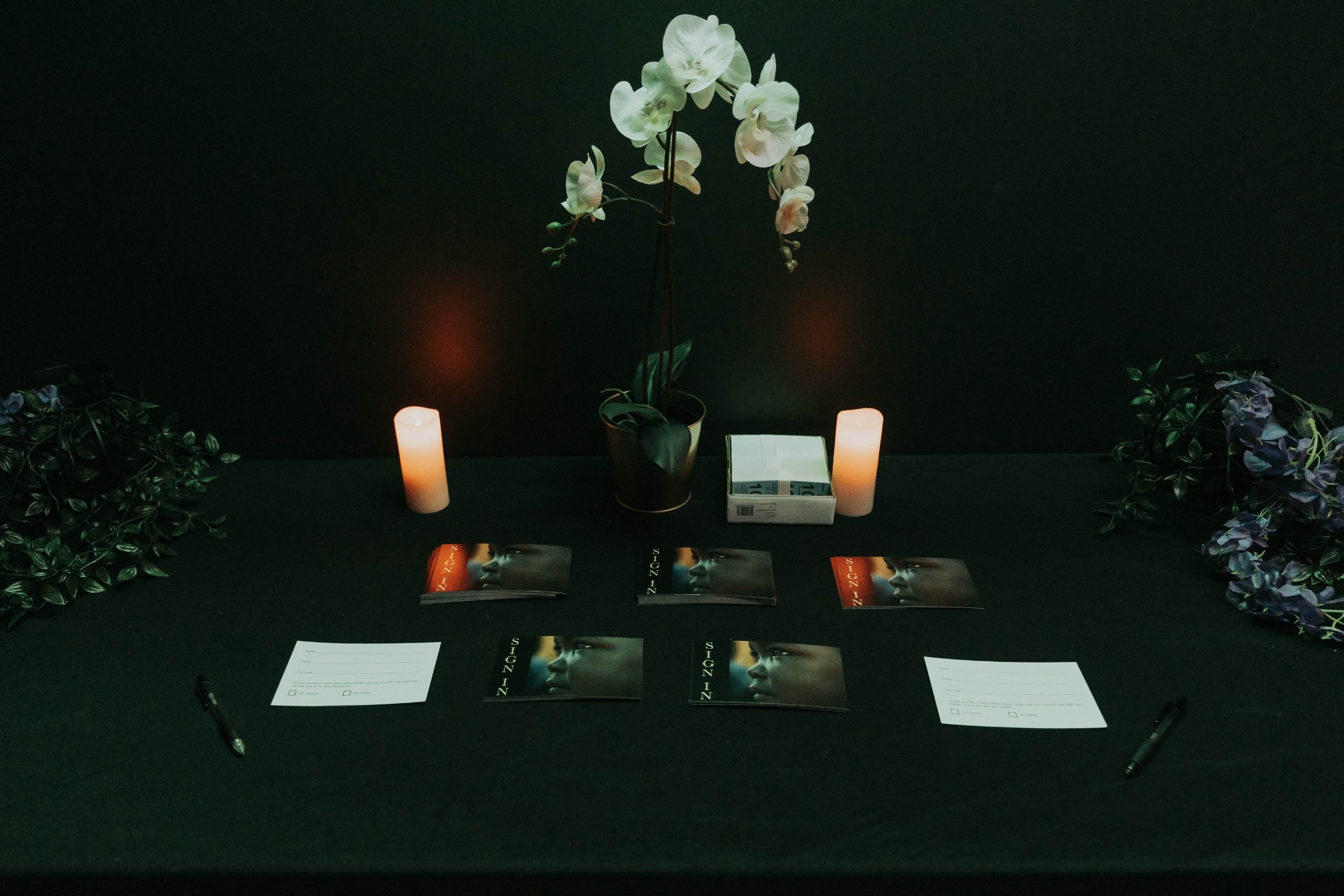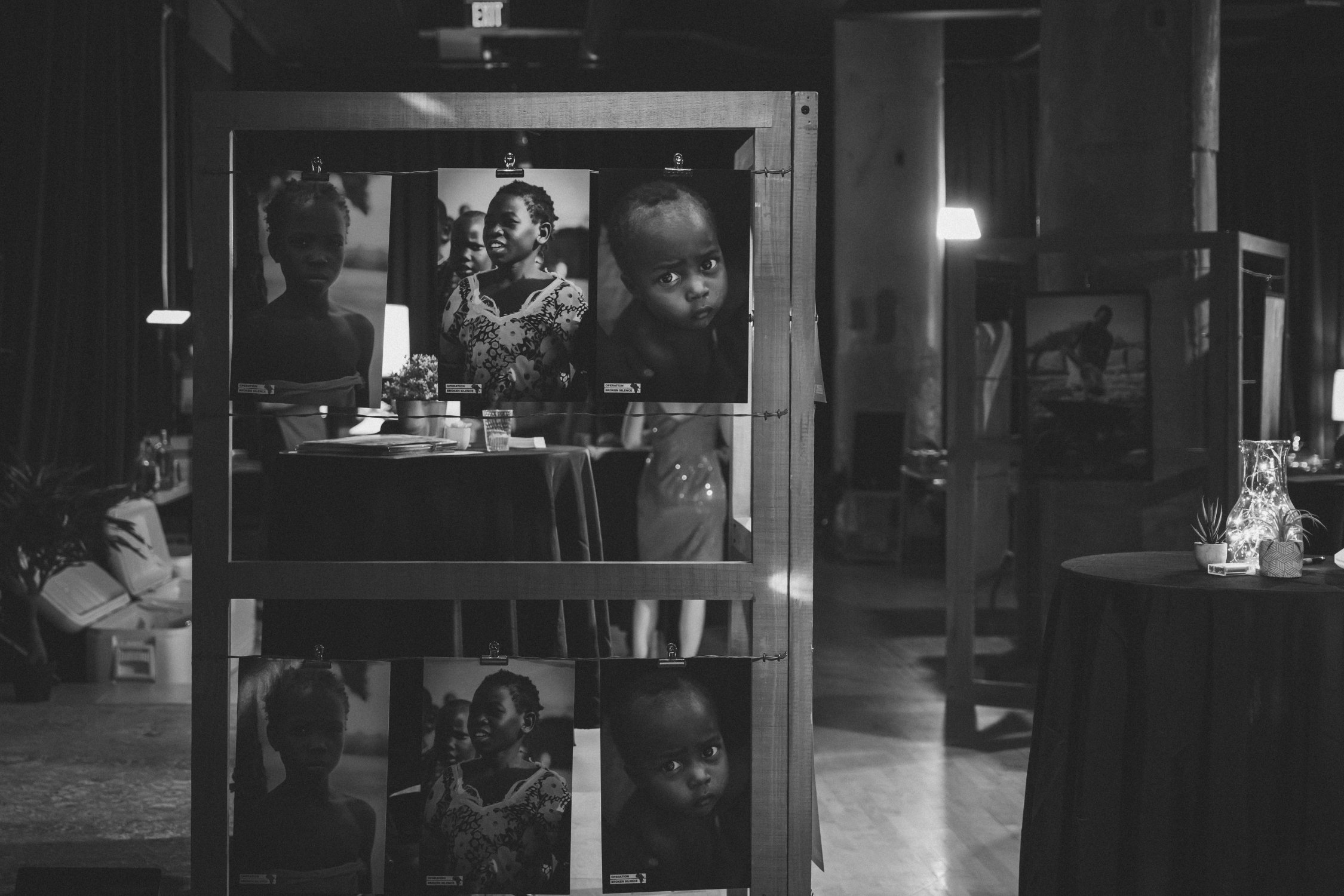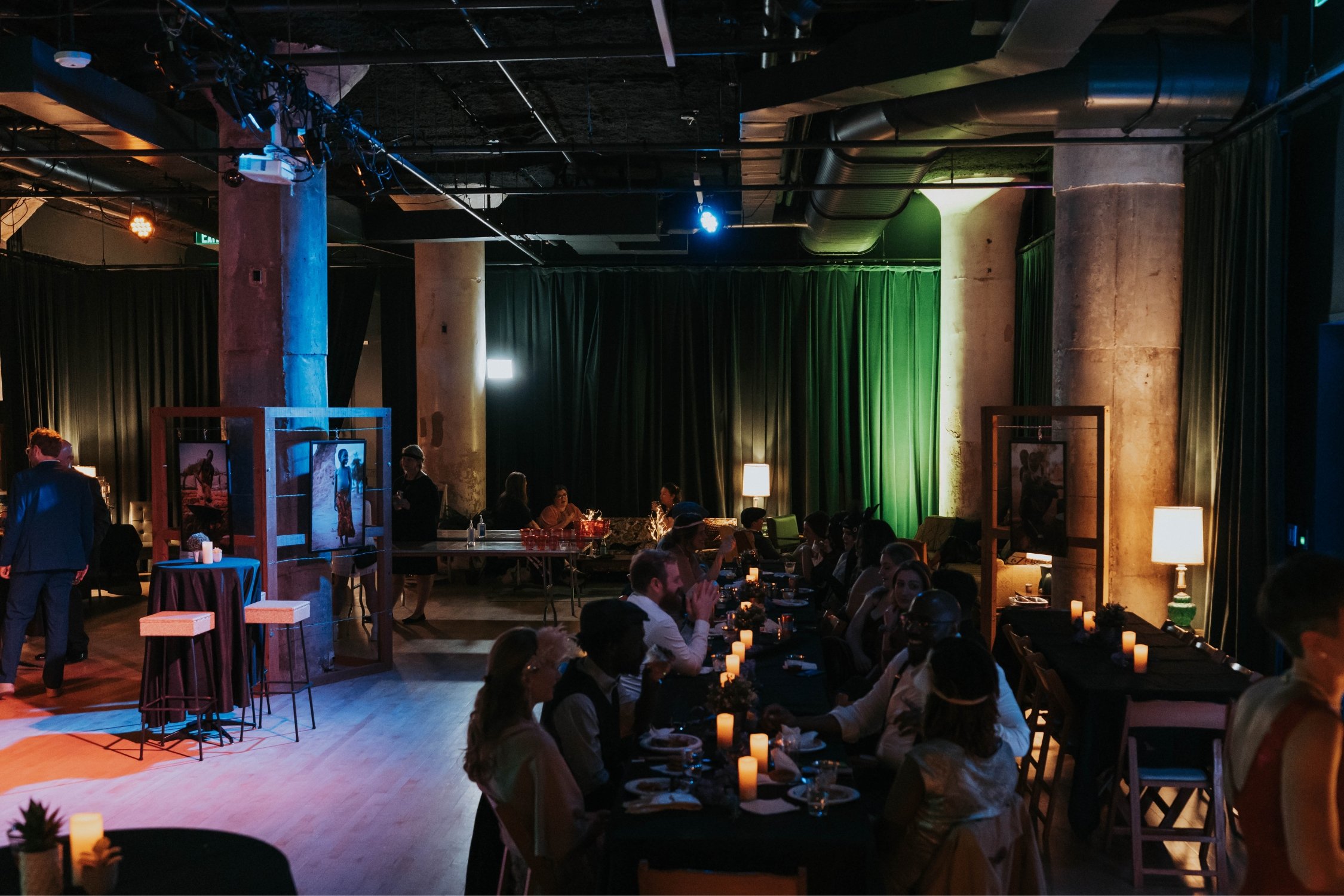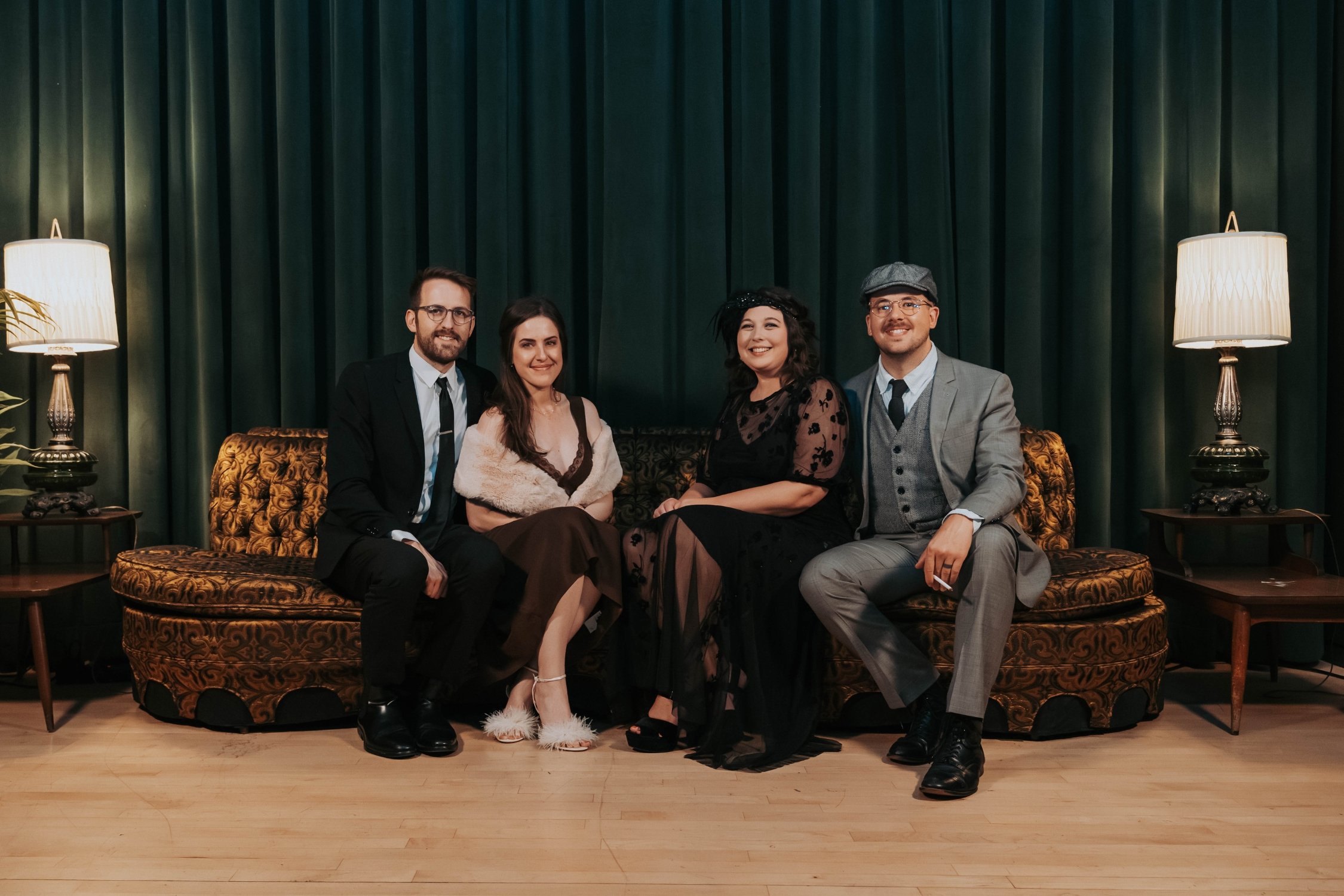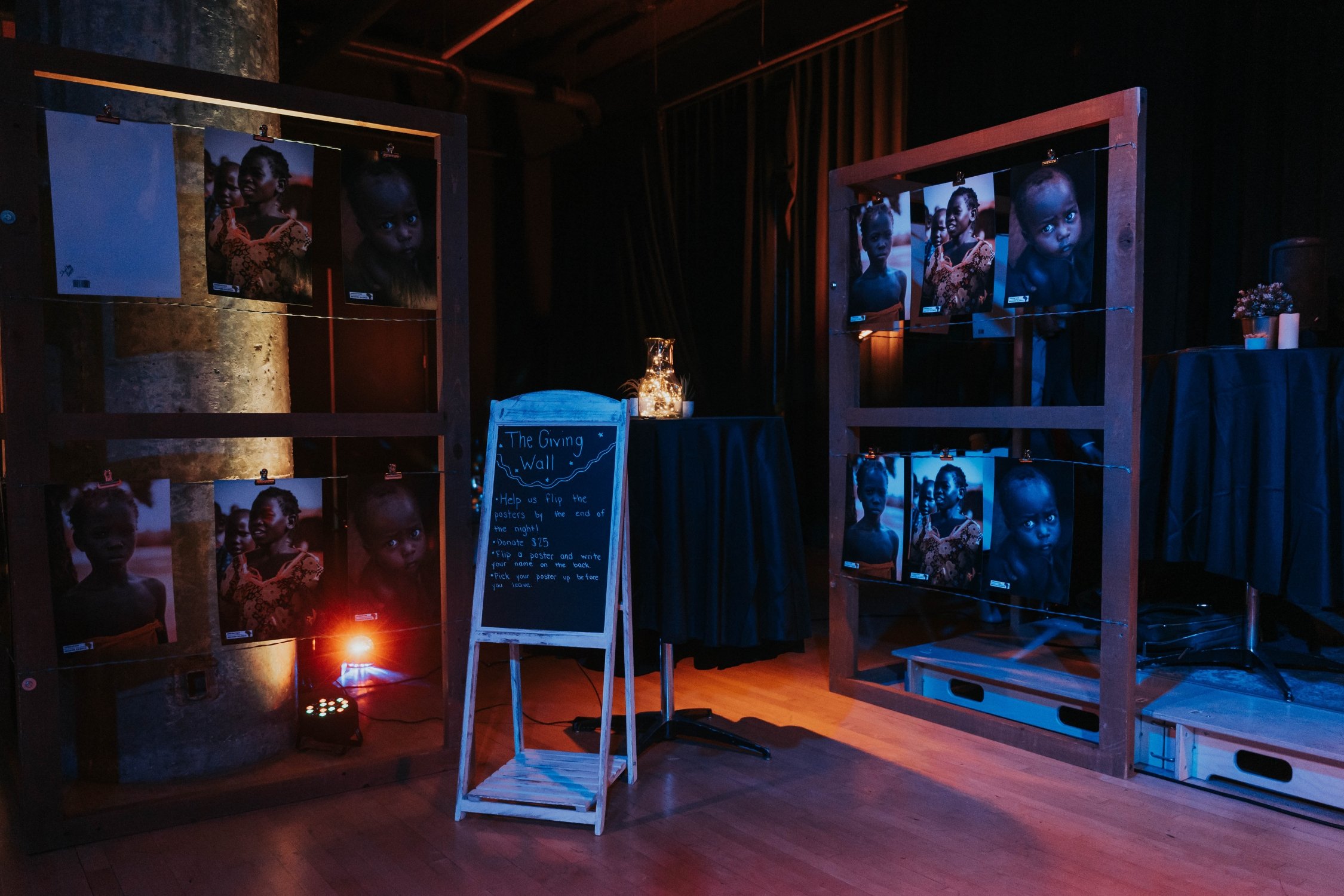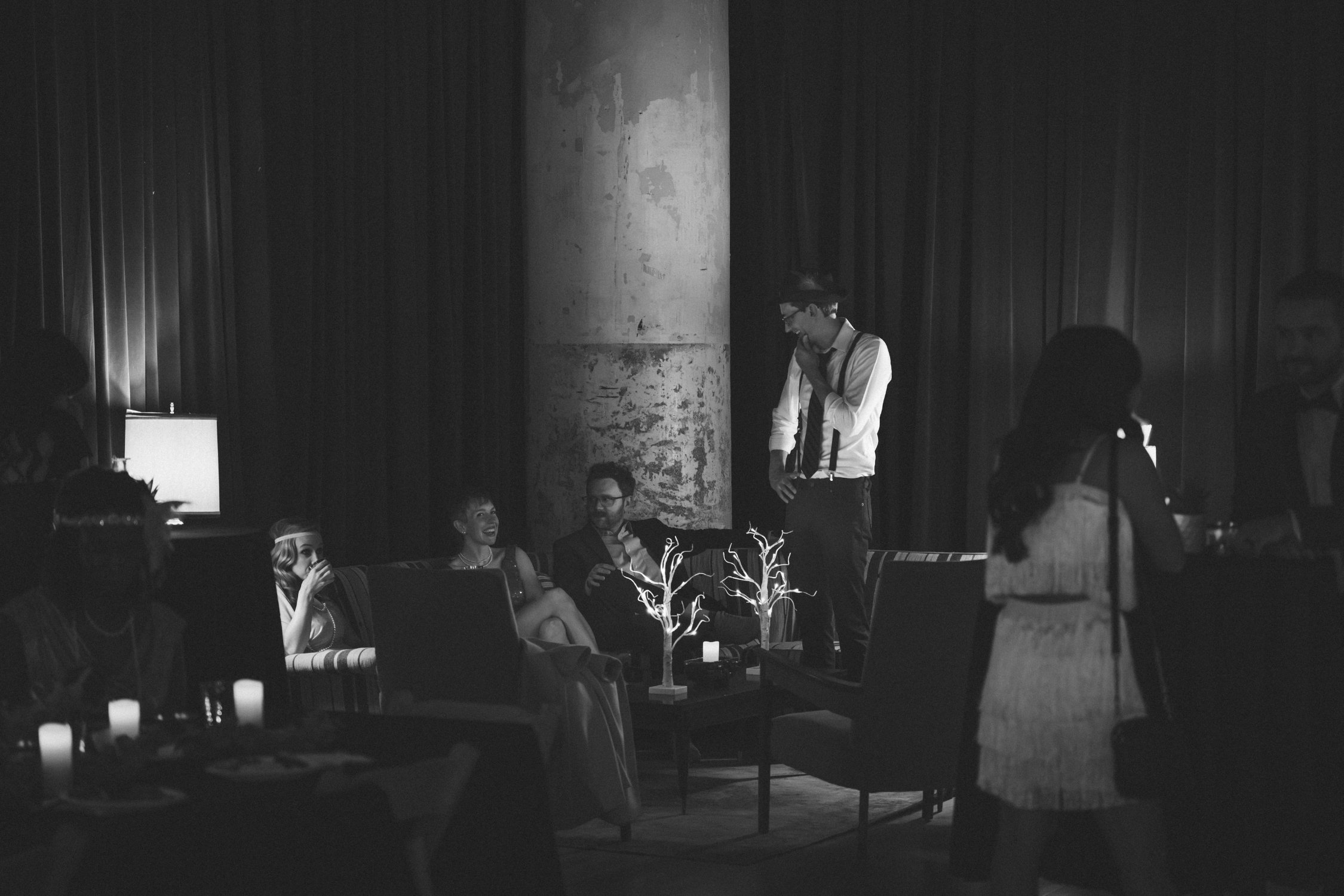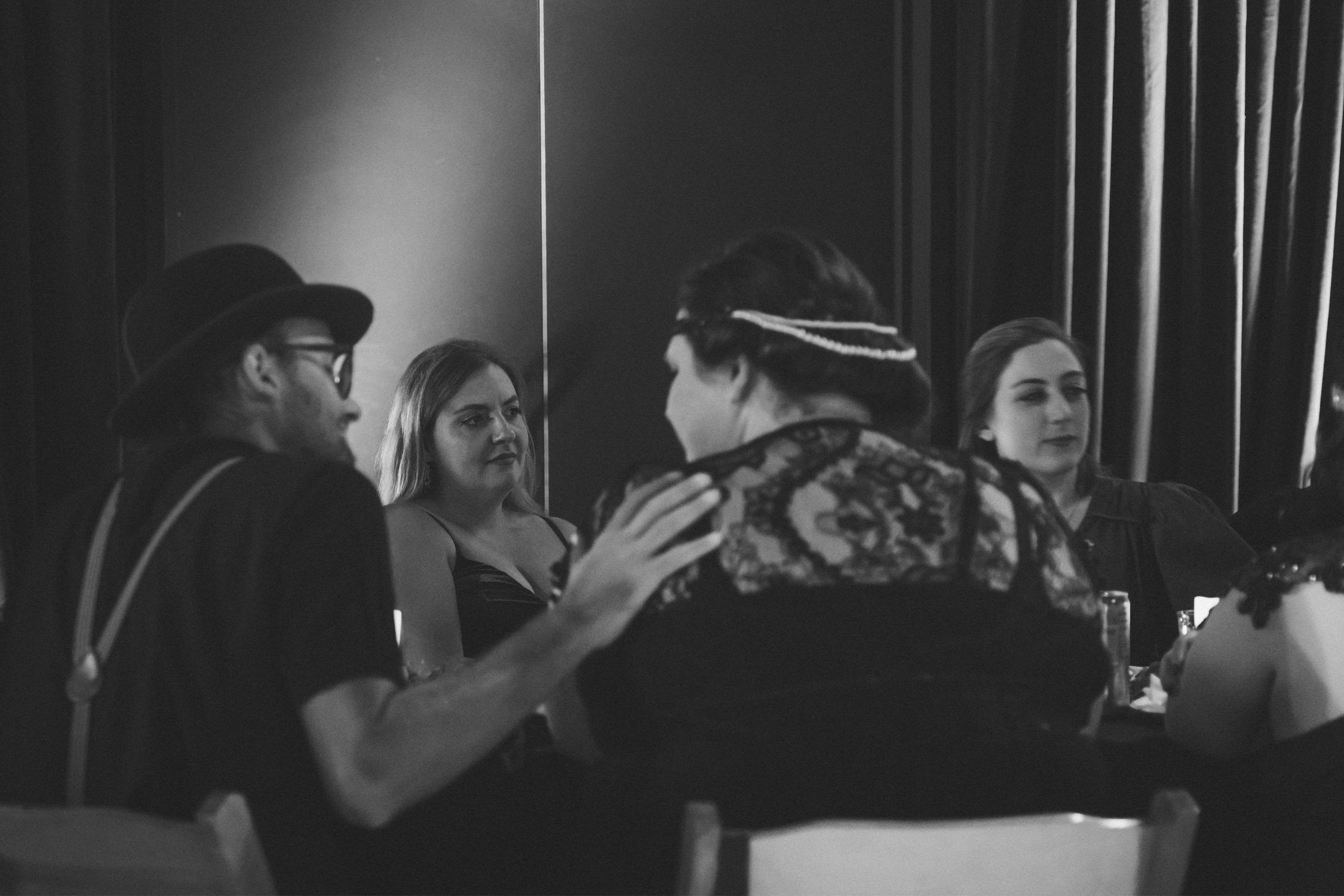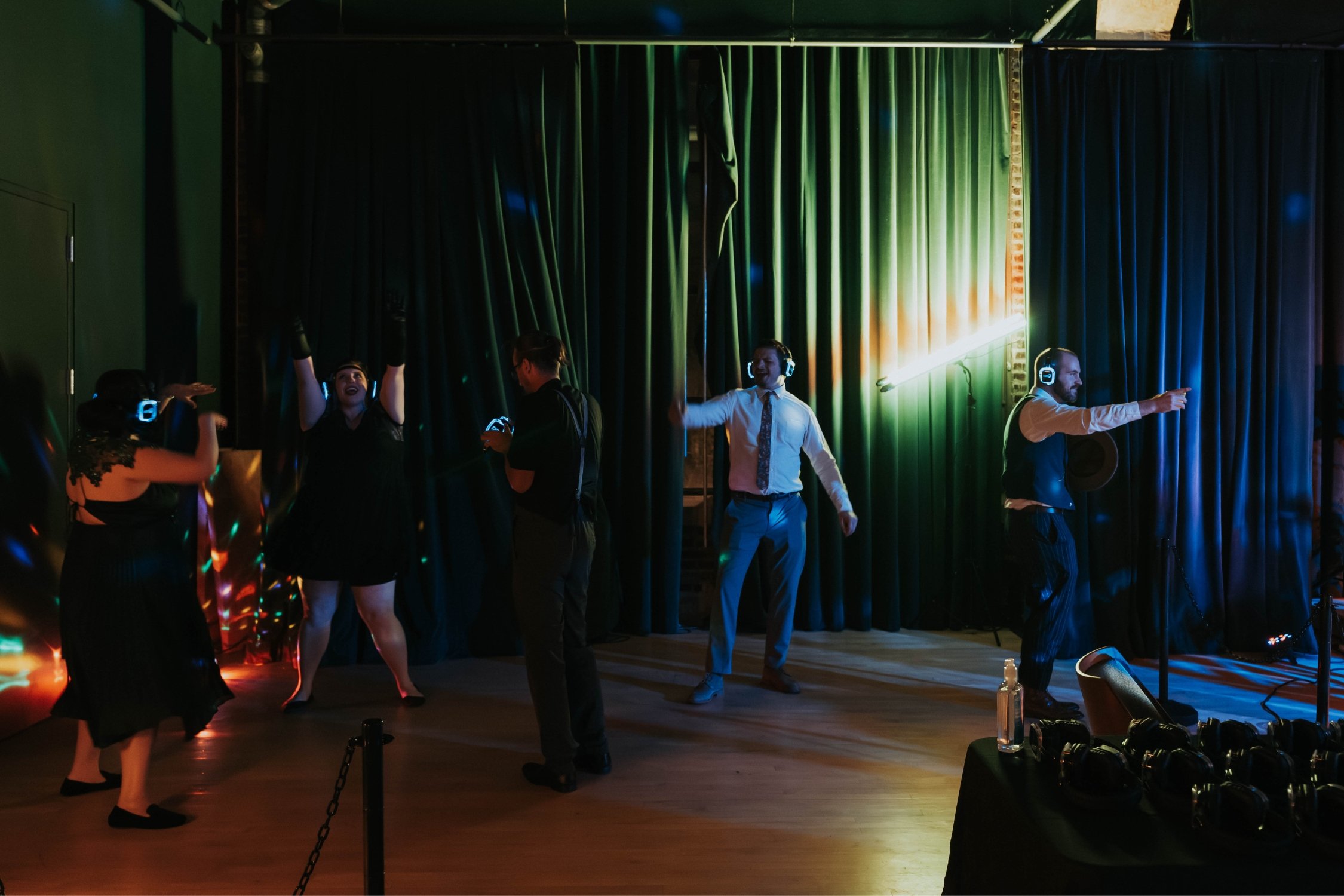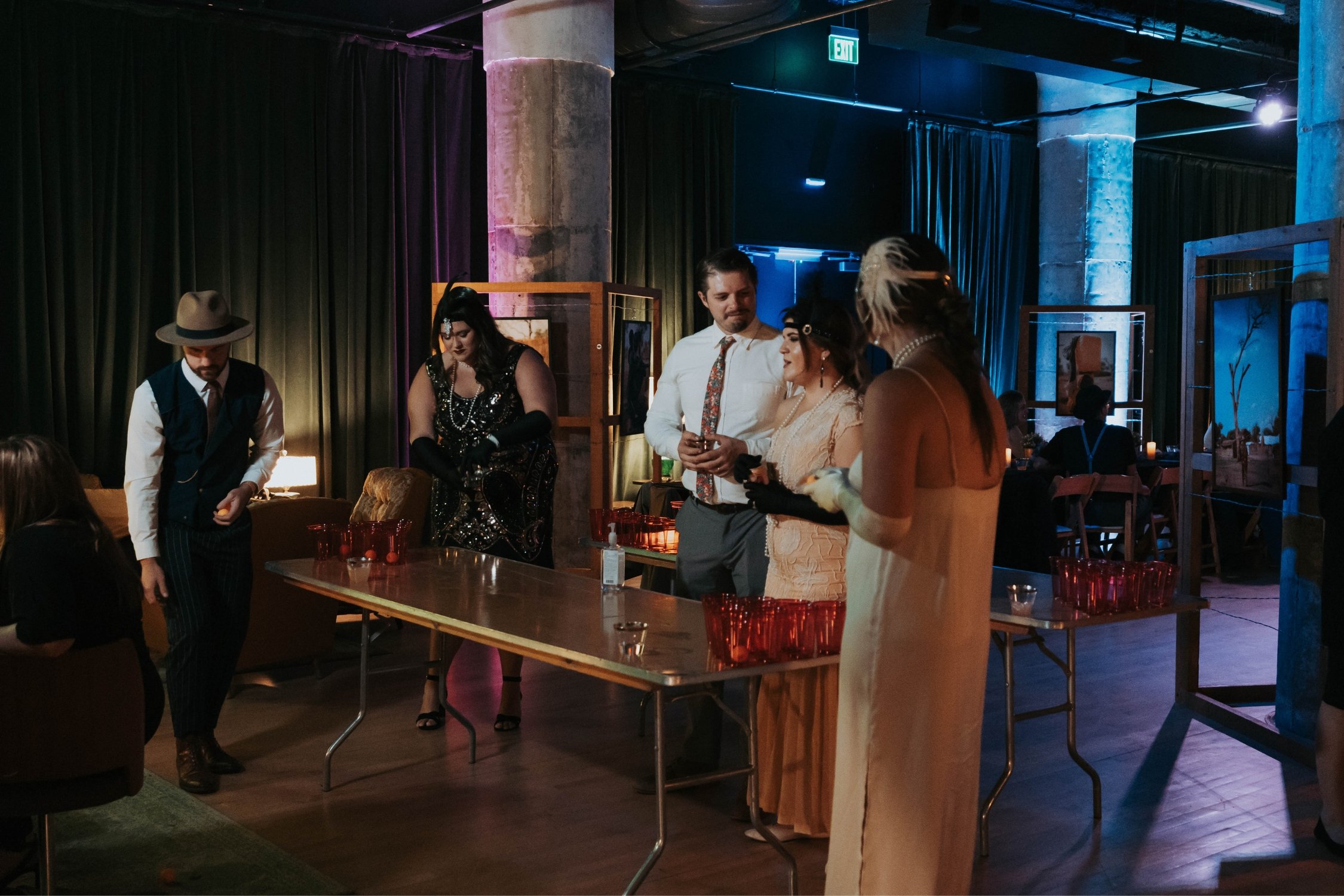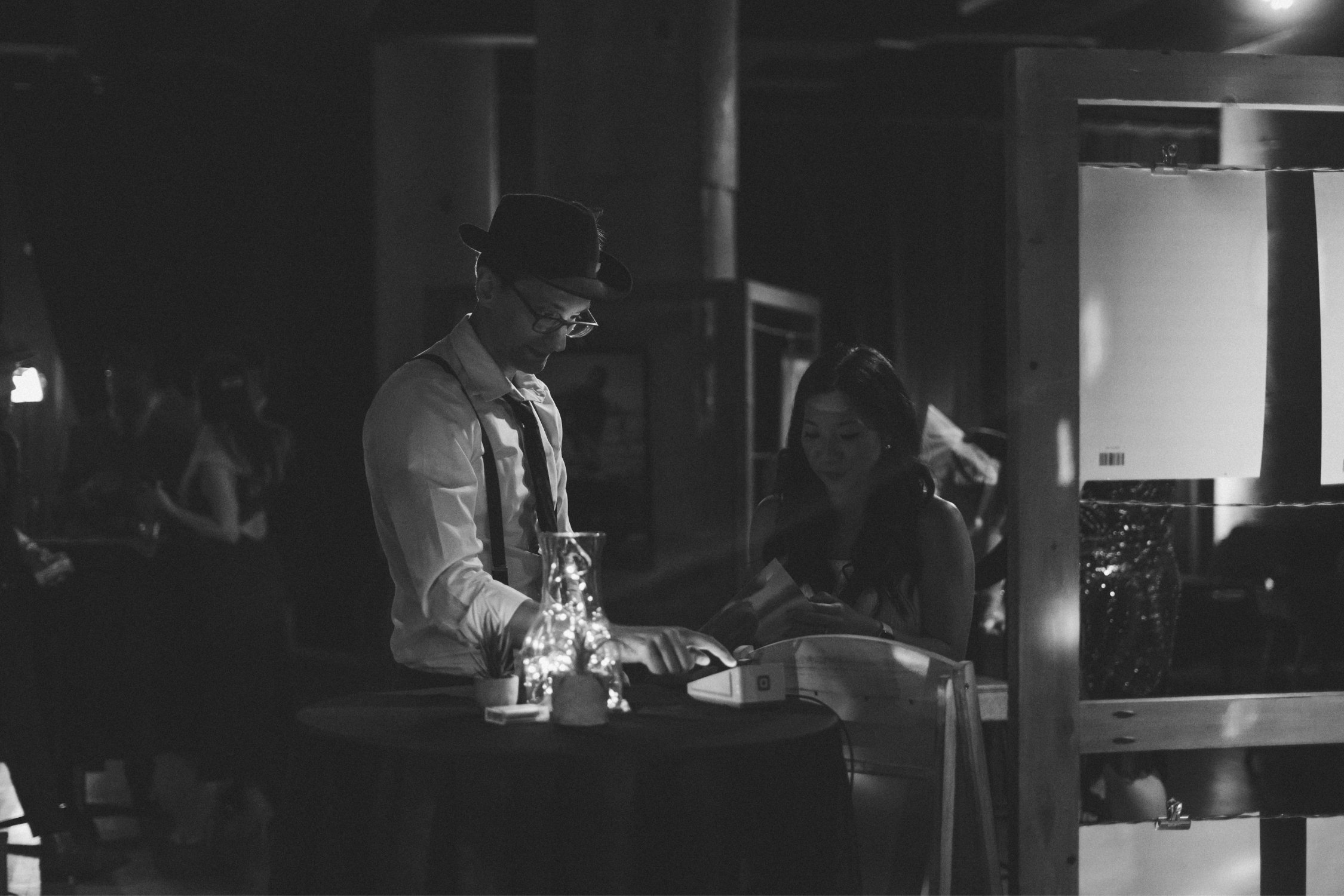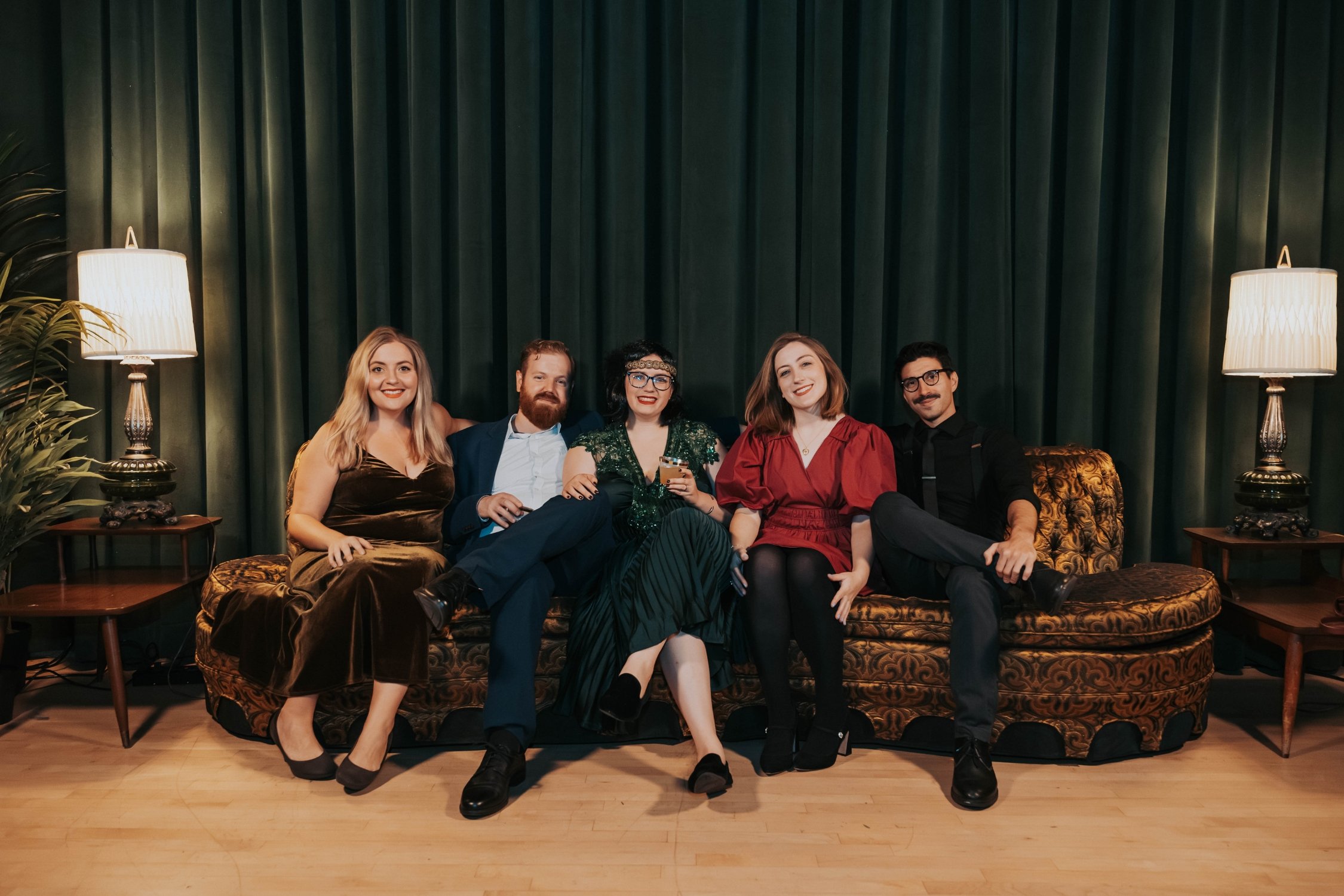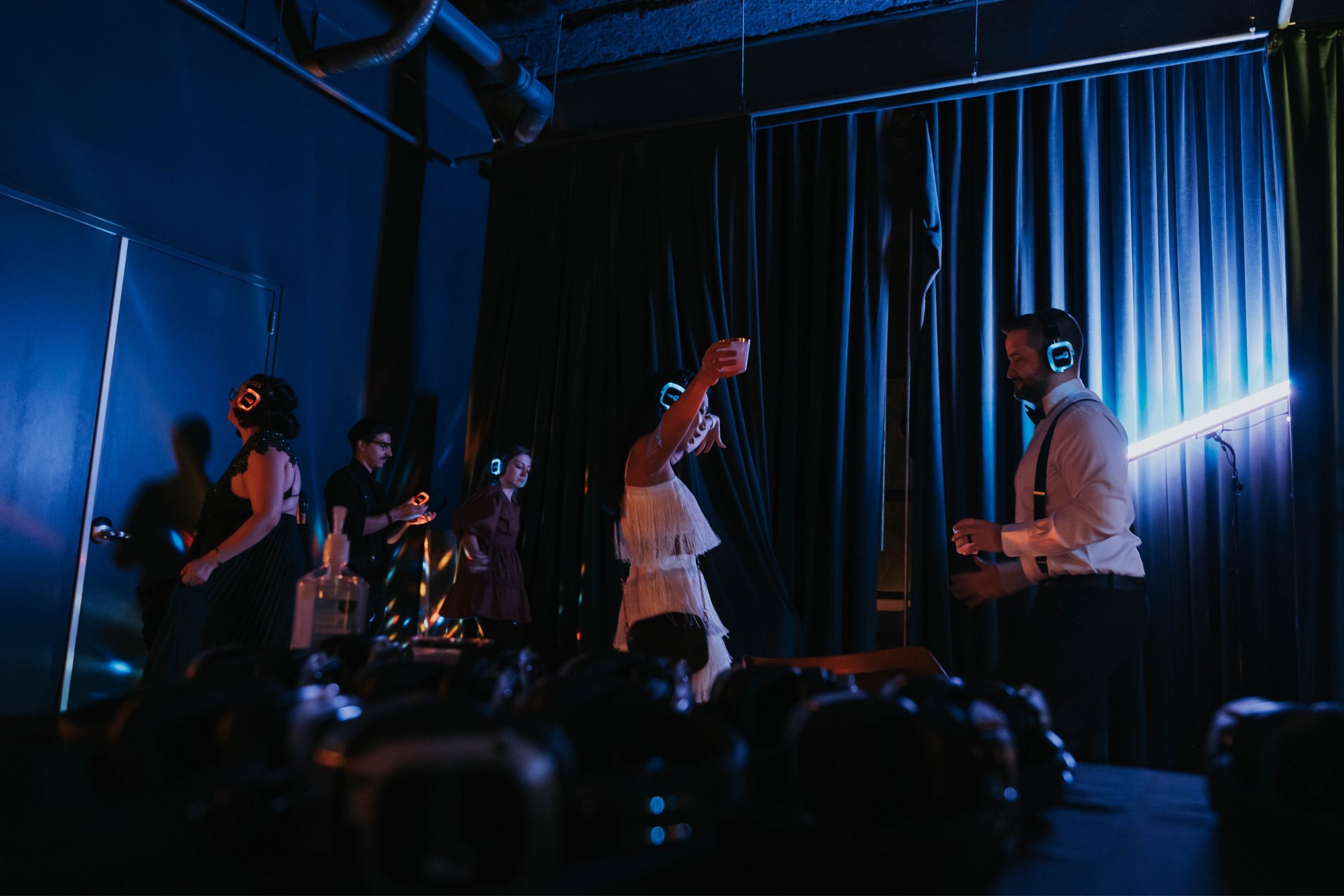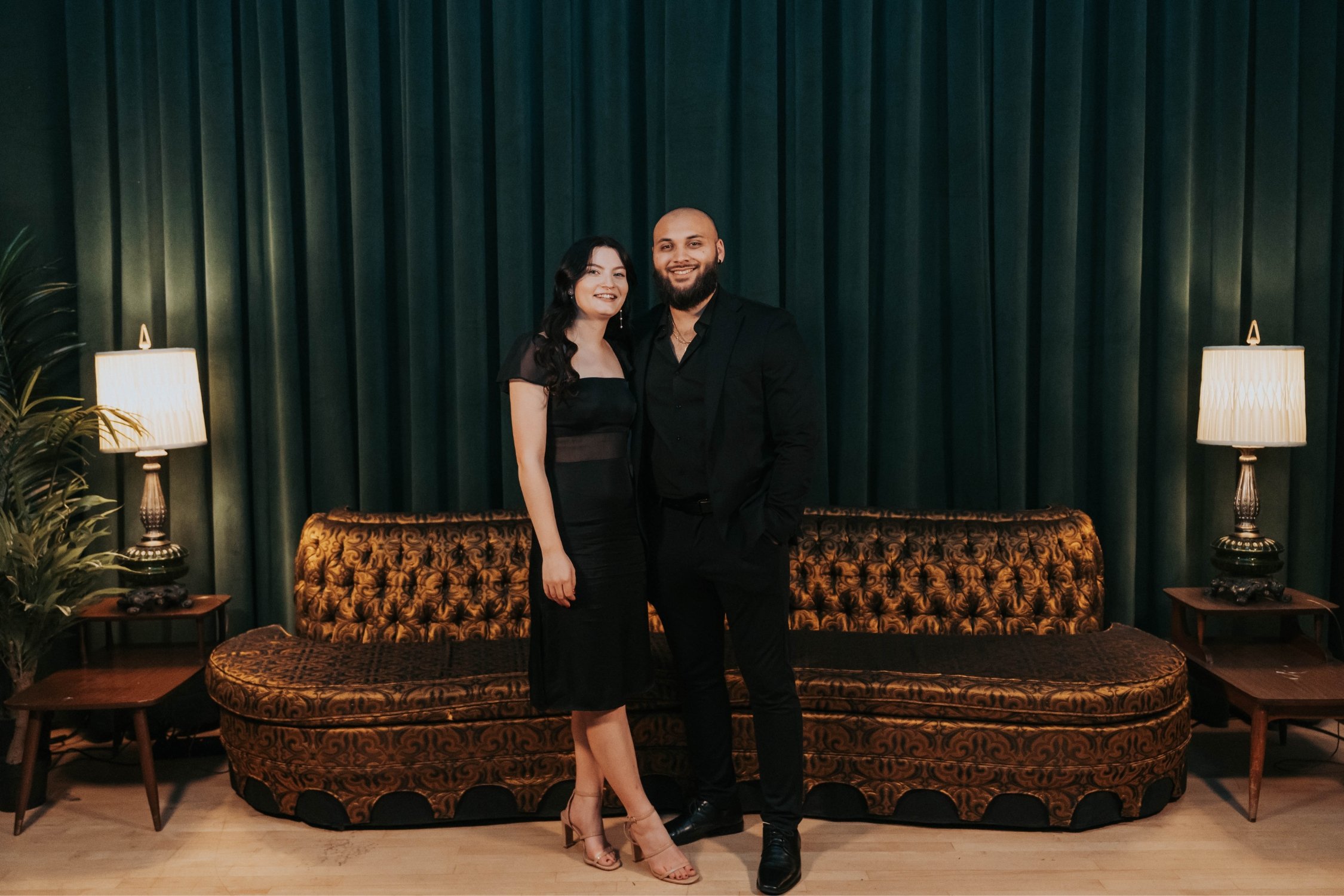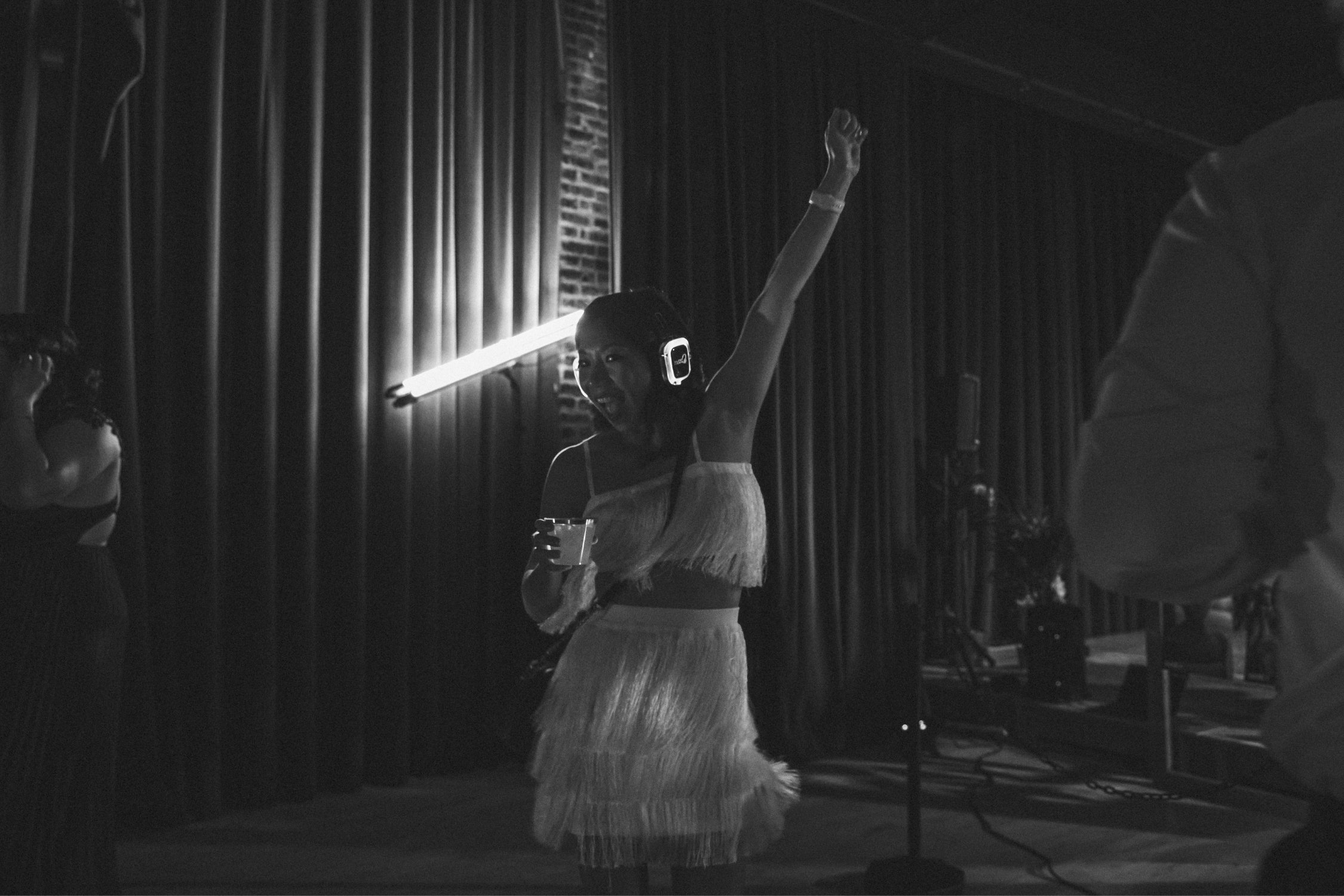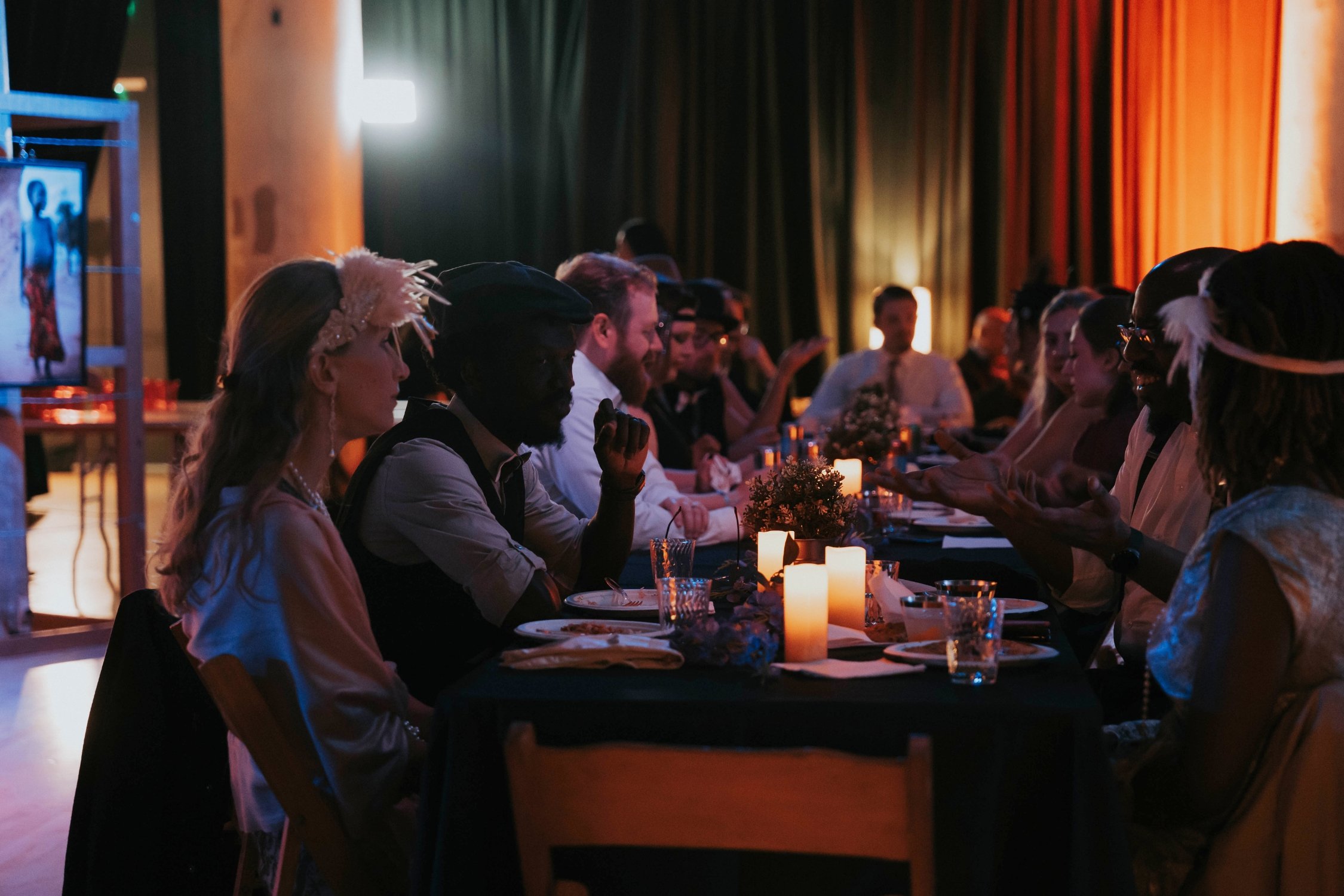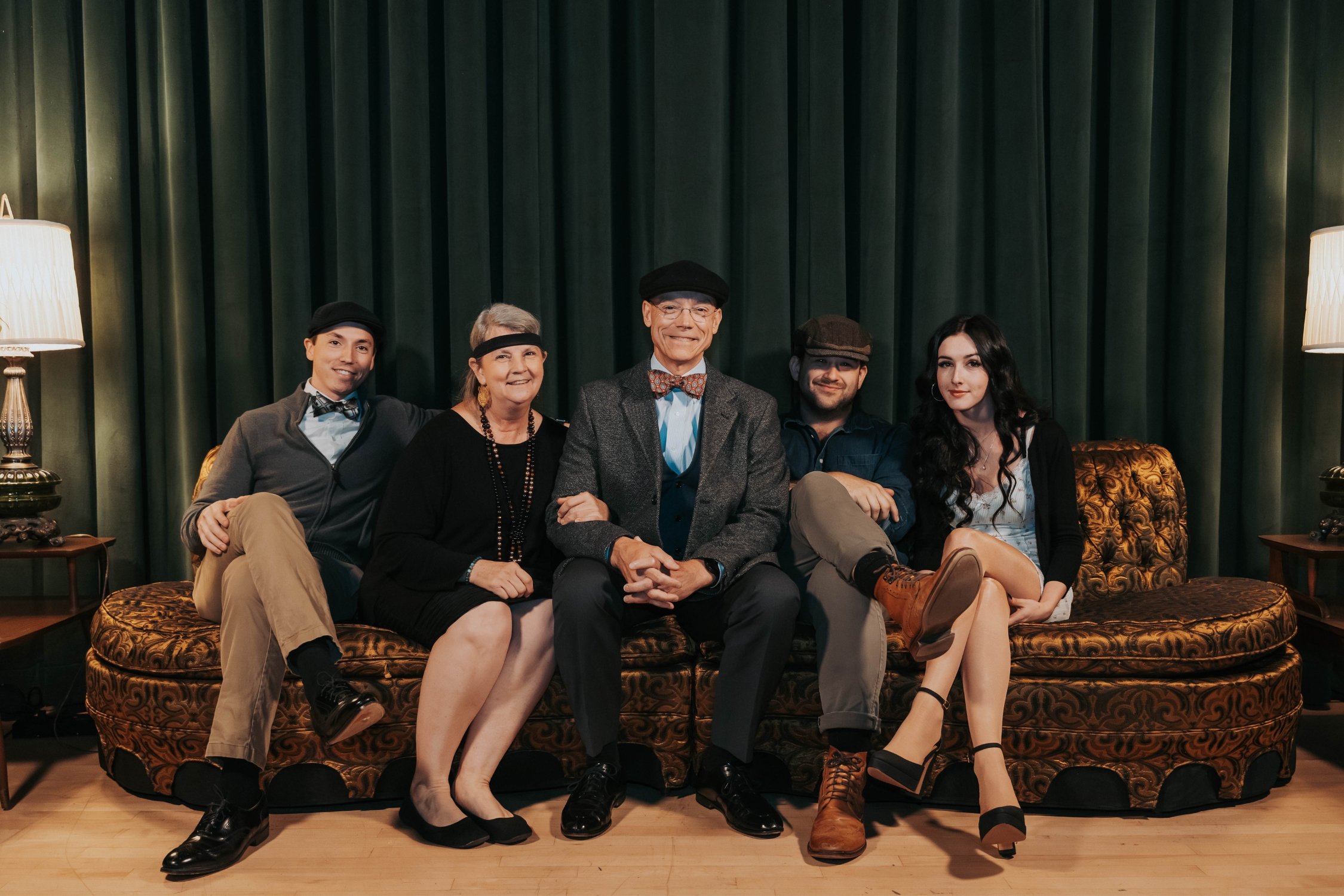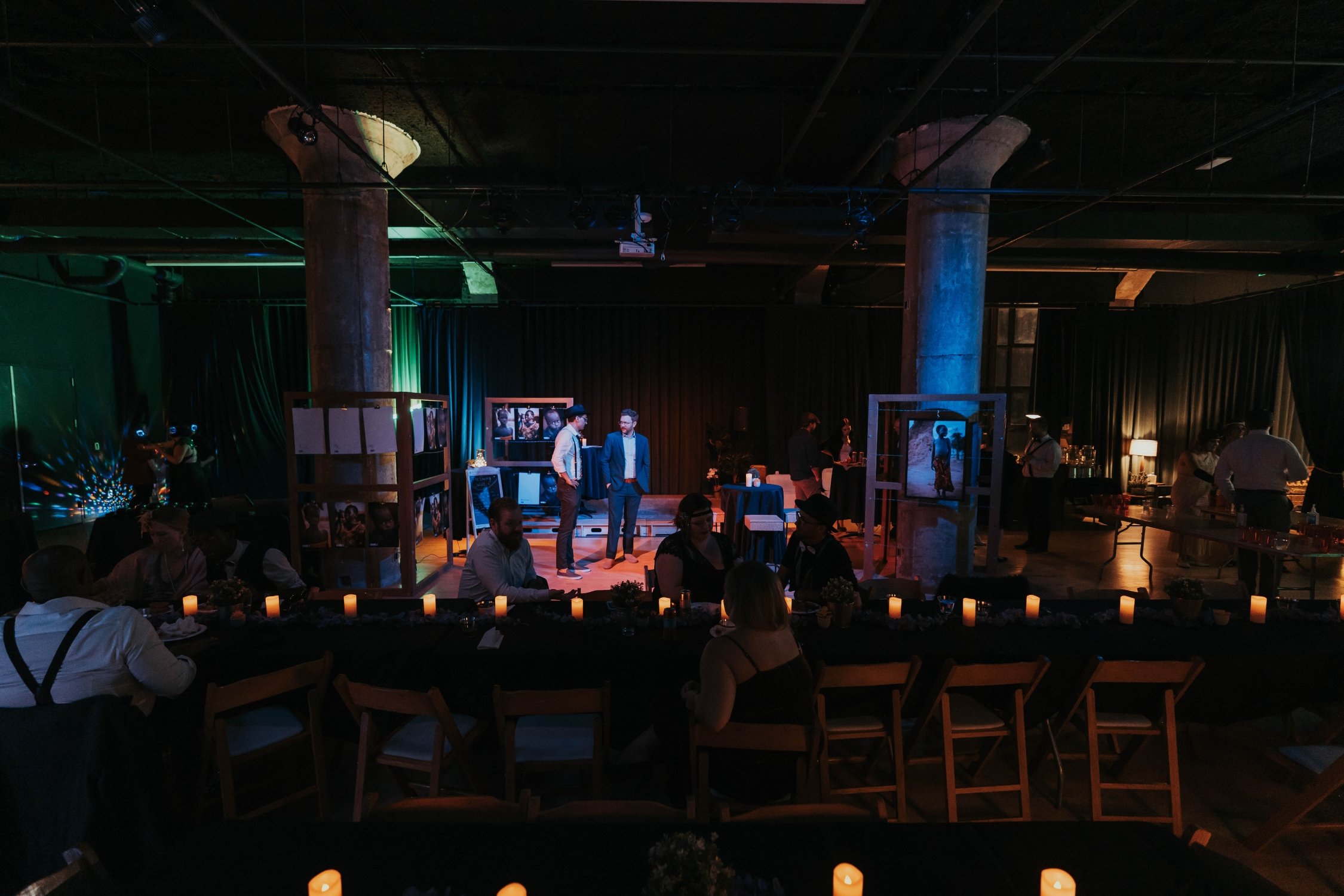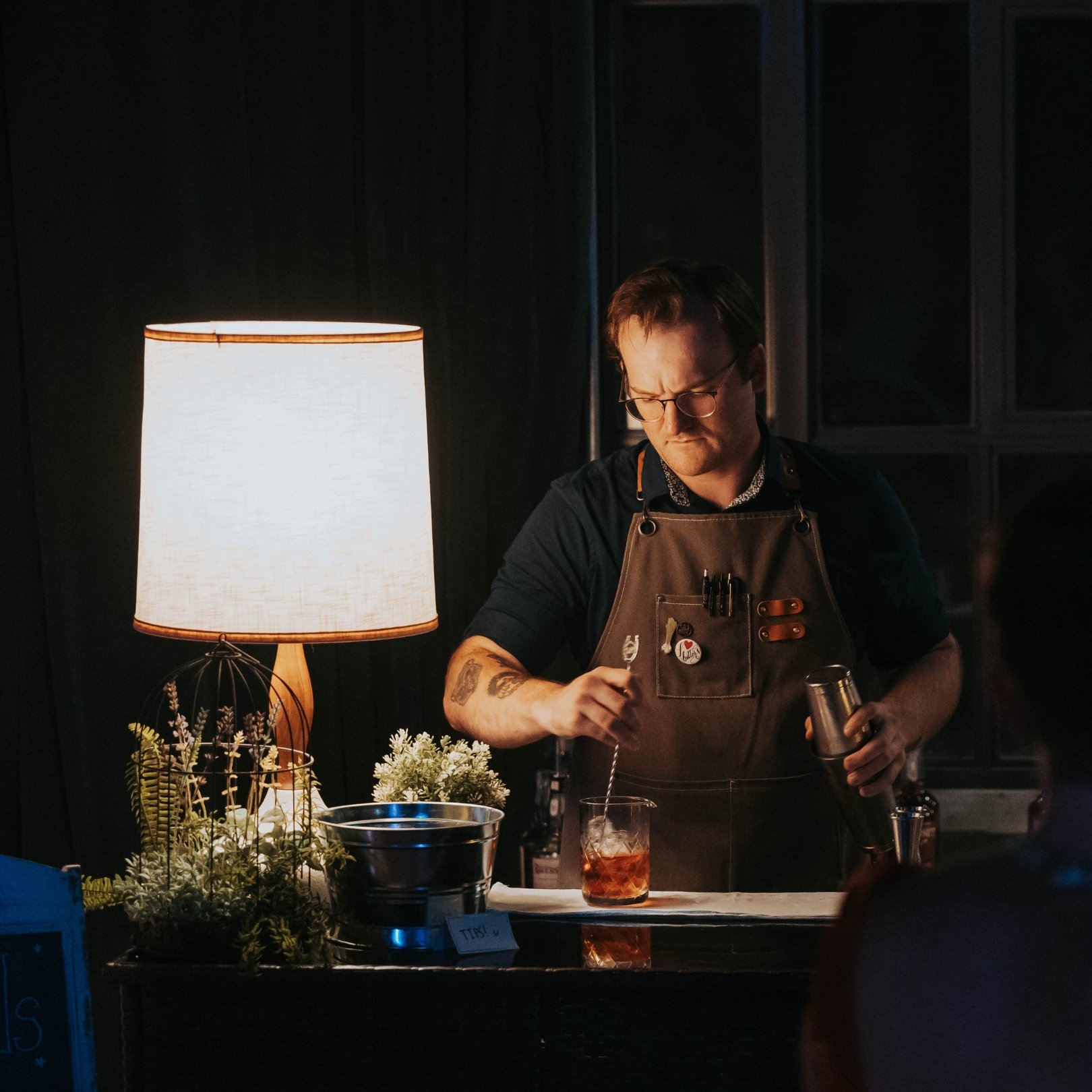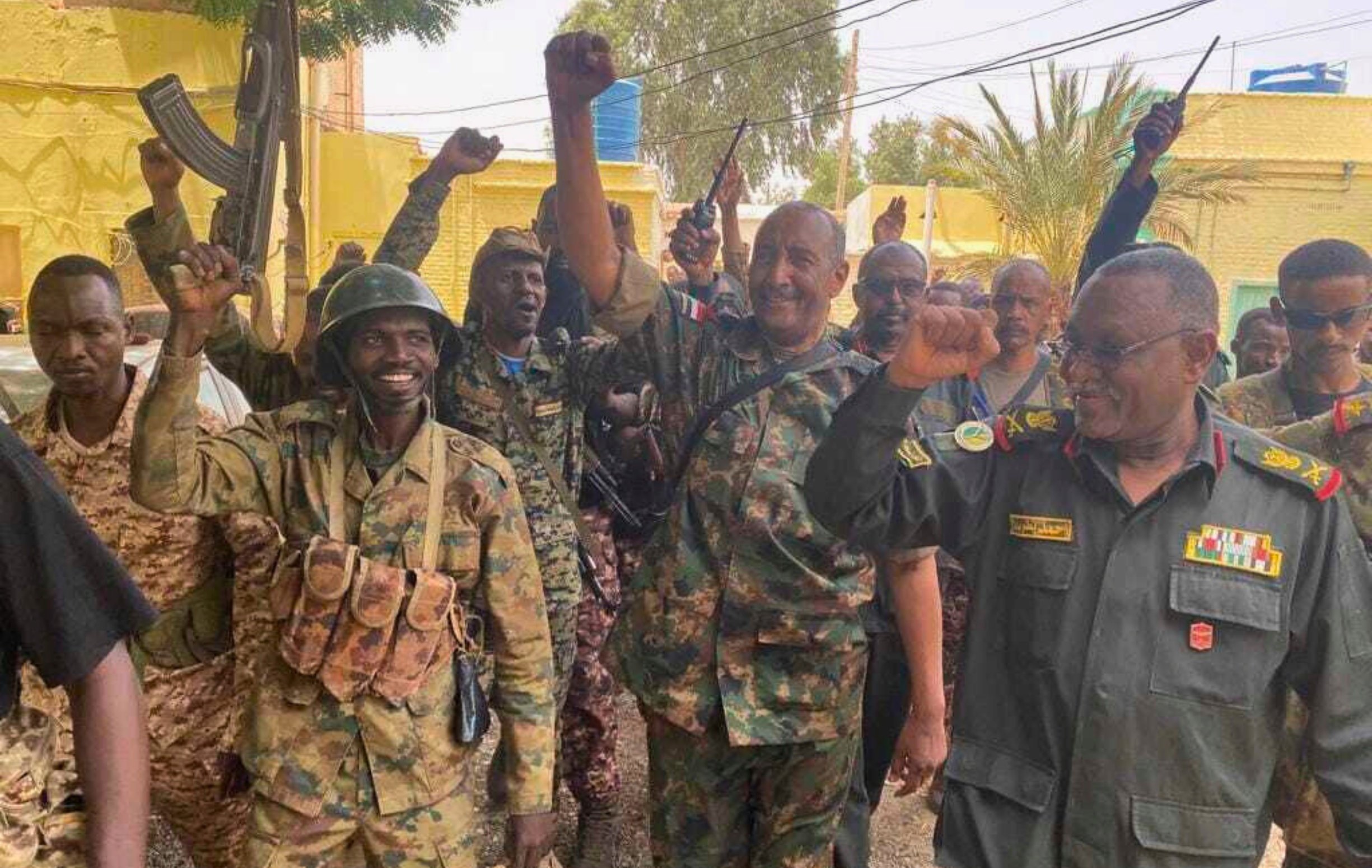News & Updates
Check out the latest from Sudan and our movement
The 11th annual Soirée For Sudan
On October 7, 2023, our supporters came together to celebrate teachers and students in Yida Refugee Camp.
On October 7, our supporters came together to celebrate teachers and students in Yida Refugee Camp. This marked the eleventh year of Soirée For Sudan. Thank you to all of you who showed up!
The evening was made possible by our sponsors: Silent Events, the Clandestine Underground, Madeline Rose Photos, Shelby Monteverde Fine Art, Whitney Winkler Art, the Episcopal Diocese of West Tennessee, Monogram Foods, and Novel Memphis.
We would also like to thank our promotional committee, event staff, and volunteers for working together to create such an intimate space!
Anya Schwartz, Tiffany Frizzell-Donnell, and Jackson Donnell served on our promotional committee.
Zack Jennings designed and served the Sudan and 1920s-themed cocktails for the evening.
Wandering Creative and Julian Harper captured the evening on camera.
Anya Schwartz, Stephen Hackett, Sara James, Taylor Austin, and Jacob Geyer assisted with setup and breakdown.
Download Photos
Hit the button below to download your photos, or find them and share on Facebook.
Stay Involved
The war in Sudan continues to cast a dark shadow over the work of our Sudanese partners. You can help them each and every month by joining our monthly giving family, The Renewal.
All of our Sudanese partners are struggling with rising costs. They need 100 of us to start giving monthly to help them continue their lifesaving work.
⚡️ Your first three monthly gifts will be matched by a private donor ⚡️
All members of The Renewal receive special perks, including a membership pin and welcome letter, discounted merch, and early access to new events and campaigns.
Members who give $35+ a month also receive free event tickets to our events! Learn more about the benefits of giving monthly.
The 14th annual Eden's Run 5K
See your photos from our annual run benefiting teachers and students in Sudan!
From October 28-30, our supporters celebrated fourteen years of Eden’s Run 5K, a virtual and in-person race bringing education to Sudan's next generation of leaders.
Runners across the United States took to neighborhoods, parks, and tracks throughout the weekend to complete their virtual 5Ks. Our supporters in Memphis, TN —where we are headquartered— gathered at Shelby Farms Park on Saturday, October 28 for an in-person run. It was a cloudy day, but the temperature was perfect!
Thank you to all of our runners for giving and fundraising! We set a goal of $7,500 that you shattered with $9,260 raised. Well done!
The run was made possible by our generous sponsors: Siskind Susser Immigration Lawyers, Buff City Soap, Hotworx (Edge District), Preservation Property Services, and Hive Bagel & Deli.
We would also like to thank our promotional committee, event staff, and volunteers for working together to make race weekend possible! Anya Schwartz, Tiffany Frizzell-Donnell, and Jackson Donnell served on our promotional committee. Jacob Geyer captured the event on camera. Anya Schwartz, Stephen Hackett, Sara James, Taylor Austin, Jacob Geyer, and Catherine Haag, Annabelle Haag, and Clara Haag made the in-person Memphis event happen. Thank you!
Download Photos
If you were at the Memphis run, use the button below to download your photos, or find them to share on Facebook.
Stay Involved
The war in Sudan continues to cast a dark shadow over the work of our Sudanese partners. You can help them each and every month by joining our monthly giving family, The Renewal.
All of our Sudanese partners are struggling with rising costs. They need 100 of us to start giving monthly to help them continue their lifesaving work.
⚡️ Your first three monthly gifts will be matched by a private donor ⚡️
All members of The Renewal receive special perks, including a membership pin and welcome letter, discounted merch, and early access to new events and campaigns.
Members who give $35+ a month also receive free event tickets to Eden’s Run 5K! Learn more about the benefits of giving monthly.
US sanctions paramilitary leaders in Sudan
The US Treasury and State Departments have issued new sanctions against leaders in the Rapid Support Forces.
The United States Treasury’s Office of Foreign Assets Control (OFAC) and State Department have imposed sanctions on top commanders in the Rapid Support Forces (RSF), correctly pointing out that “members of the Rapid Support Forces (RSF) in Darfur have committed atrocities and other abuses, inducing ethnically motivated killings, targeted abuses against human rights activists and defenders, conflict-related sexual violence, and looting and burning of communities.”
Sudan’s military regime disintegrated on April 15, 2023. The army and paramilitary Rapid Support Forces, the two primary factions in the regime, went to war with each for control of Sudan. Fighting has spread across the country, with millions of Sudanese caught in the crossfire and ethnic minorities facing famine, war crimes, and genocide.
The US government is specifically targeting Abdelrahim Dagalo, the RSF’s deputy commander and brother to top RSF commander Hemeti, as well as Abdul Rahman Juma, the RSF’s top general in West Darfur.
Abdelrahim is also being designated for being a foreign person who is or has been a leader, official, senior executive officer, or member of the board of directors of the RSF, an entity that has, or whose members have, engaged in the targeting of women, children, or any other civilians through the commission of acts of violence (including killing, maiming, torture, or rape or other sexual violence), abduction, forced displacement, or attacks on schools, hospitals, religious sites, or locations where civilians are seeking refuge, or through conduct that would constitute a serious abuse or violation of human rights or a violation of international humanitarian law relating to the tenure of such leader, official, senior executive officer, or member of the board of directors.
As a result of today’s action, all property and interests in property of the designated person described above that are in the United States or in the possession or control of U.S. persons are blocked and must be reported to OFAC. In addition, any entities that are owned, directly or indirectly, individually or in the aggregate, 50 percent or more by one or more blocked persons are also blocked. Unless authorized by a general or specific license issued by OFAC, or exempt, OFAC’s regulations generally prohibit all transactions by U.S. persons or within (or transiting) the United States that involve any property or interests in property of designated or otherwise blocked persons.
In addition, financial institutions and other persons that engage in certain transactions or activities with the sanctioned entities and individuals may expose themselves to sanctions or be subject to an enforcement action. The prohibitions include the making of any contribution or provision of funds, goods, or services by, to, or for the benefit of any designated person, or the receipt of any contribution or provision of funds, goods, or services from any such person.
According to Secretary of State Antony Blinken:
The Department of State is imposing visa restrictions on RSF General and West Darfur Sector Commander, Abdul Rahman Juma, for his involvement in a gross violation of human rights. According to credible sources, on June 15, 2023, RSF forces led by General Juma kidnapped and killed the Governor of West Darfur, Khamis Abbakar, and his brother. This act came just hours after Abbakar’s public statements condemning the actions of the RSF.
The United States continues to call on all external actors to avoid fueling the conflict. We will not hesitate to use the tools at our disposal to hinder the ability of the RSF and Sudanese Armed Forces (SAF) to further prolong this war, and we will also use such tools to deter any actor from undermining the Sudanese people’s aspiration for peace and civilian, democratic rule. We will act to promote accountability for those responsible for atrocities and to pursue justice for the victims. The parties must comply with their obligations under international humanitarian law to protect civilians, hold accountable those responsible for atrocities or other abuses, allow unhindered humanitarian access, and negotiate an end to the conflict.
We Need Your Help
In our 12 years of working alongside Sudanese heroes, we’ve never seen anything like this. Extreme violence is spreading. Entire cities and villages are being destroyed. Famine looms. And program costs are skyrocketing.
Our Sudanese partners are struggling. They need 100 of us to start giving at least $50/month to help them continue their lifesaving work. ⚡️This is a big matchmaking campaign!⚡️ The first 100 new monthly givers will be matched by a private donor for 3 months.
The Renewal is our passionate family of monthly givers supporting Sudanese heroes. You’ll receive updates from our partners roughly once a quarter, a donation receipt each month, and an annual giving statement at the beginning of each year.
Operation Broken Silence is a registered 501(c)(3) nonprofit organization. Your donations are tax-deductible within the guidelines of U.S. law.
Can’t give monthly? Donate once or start a fundraising page and ask friends and family to give!
Sudan Letter To The United Nations
Operation Broken Silence is joining 22 other human rights and security organizations in calling on the United Nations Security Council and General Assembly to step up direct and indirect action.
With the crisis in Sudan spiraling out of control, Operation Broken Silence is joining 22 other human rights and security organizations in calling on the United Nations Security Council and General Assembly to step up direct and indirect action.
Sudan’s military regime disintegrated on April 15, 2023. The army and paramilitary Rapid Support Forces (RSF), the two primary groups in the regime, went to war with each for control of Sudan.
Fighting has spread across the country, with millions of the Sudanese people caught in the crossfire and ethnic minorities facing famine, war crimes, and even genocide. The area hit hardest by the war is West Darfur, where the RSF and their Arab militia allies have already killed well over 10,000 people. South Darfur is seeing increased levels of targeted violence, too.
The letter highlights a number of recommendations put forward by the Global Centre for the Responsibility to Protect, including but not limited to:
Requesting the Security Council President to invite briefers from civil society and affected communities to formal and informal meetings on atrocity situations.
Refraining from exercising the right of veto to block Security Council action aimed at averting or halting the commission of mass atrocities, for permanent members of the Security Council in line with the Political Declaration on Suspension of Veto Powers in Cases of Mass Atrocities and the Accountability, Coherence and Transparency Group’s Code of Conduct.
Establishing a commission of inquiry, monitoring mechanism, fact-finding mission or investigative mechanism aimed at holding perpetrators of atrocity crimes to account.
Calling on states to halt the flow of arms and military equipment to armed forces or groups suspected of committing or planning to commit atrocity crimes.
Establishing a UN peace operation or special political mission aimed at halting or averting the commission of atrocity crimes, with a mandate to monitor and promote human rights and protect civilians.
The letter has been sent to the Office of the President and the General Assembly Affairs Branch of the United Nations, as well as the Office of African Affairs, Sudan and South Sudan at the U.S. State Department, which has passed the letter along to U.S. Mission to the United Nations.
We Need Your Help
In our 12 years of working alongside Sudanese heroes, we’ve never seen anything like this. Extreme violence is spreading. Entire cities and villages are being destroyed. Famine looms. And program costs are skyrocketing.
Our Sudanese partners are struggling. They need 100 of us to start giving at least $50/month to help them continue their lifesaving work. ⚡️This is a big matchmaking campaign!⚡️ The first 100 new monthly givers will be matched by a private donor for 3 months.
The Renewal is our passionate family of monthly givers supporting Sudanese heroes. You’ll receive updates from our partners roughly once a quarter, a donation receipt each month, and an annual giving statement at the beginning of each year.
Operation Broken Silence is a registered 501(c)(3) nonprofit organization. Your donations are tax-deductible within the guidelines of U.S. law.
Can’t give monthly? Donate once or start a fundraising page and ask friends and family to give!
Backing Sudan’s civilians is the only option left
Sudan is changing in the fires of war and the fires of civil revolution. The latter must prevail, and diplomacy must change.
In this photo released by the Sudanese Army on Tuesday, May 30, 2023, General Abdel-Fattah Burhan visits his soldiers on the Khartoum battlefield. (Sudanese Army via AP)
It took mere days of war in Sudan to show that standard diplomatic efforts to contain the violence would fail. And fail they have, miserably so. Since fighting broke out between army and paramilitary forces in April, negotiations have come and gone, humanitarian conditions have surged past emergency thresholds, and the abhorrent generals seem more hellbent on killing anyone who gets in their way with each passing week.
Current efforts are faltering and will likely collapse soon. IGAD, the East African security and economic bloc of which Sudan is a member, recently proposed a ceasefire and peace initiative that would see armed peacekeepers deployed to Khartoum. A Sudanese army general responded with the threat “I swear to god, not one of them would make it back.” Representatives from both sides are now in Jeddah to try to re-start talks, but the prevailing attitude on the frontlines is this one of extreme violence.
Millions of ordinary Sudanese citizens —the beautiful, diverse lifeblood of the country— face grim choices that compound by the hour. Life in Sudan was already difficult before this war due to the regime’s incompetence, but it is now becoming impossible. Where food can be found, prices have skyrocketed. Access to medical care is so degraded that entire swaths of the population have no healthcare access at all. And all estimated counts of the dead and wounded likely represent a fraction of reality.
A darkness beyond civil war and humanitarian catastrophe
The past few weeks have proven this crisis is exceedingly more dangerous than the “backsliding” and “risk of full-blown civil war and humanitarian crisis” narratives that abound in intergovernmental bodies and minimal media coverage. The fighting between General Abdel Fattah al-Burhan’s Sudan Armed Forces (SAF) and General Mohamed Hamdan Dagolo’s paramilitary Rapid Support Forces (RSF) has unlocked a darkness that tears at the very fabric of humanity itself.
Images of bloodied piles of dead soldiers and the destruction of basic services in Khartoum continue surfacing on social media, and the country’s once populous capital is being abandoned en masse by her citizenry.
In the long-oppressed Darfur region, genocidal massacres of the Masalit people group by the RSF and their local allies abound, with other ethnic minorities across the oppressed periphery staring down the barrel of extermination. Tribal leaders in West Darfur say over 10,000 of their people have already been killed in the region. Satellite imagery shows entire neighborhoods and villages have been burned to the ground. The authoritative Sudan Conflict Observatory has found evidence of the “targeted destruction of at least 26 communities” by the RSF up to July 10, the cutoff date of their last reporting period more than two weeks ago.
Meanwhile, in the defiant southern borderlands, the highly-restrained rebel force in the Nuba Mountains are done watching the SAF-RSF war encroach on their borders. Seeing and hearing the blaring sirens of genocide in Darfur, Nuba rebels have ended their fragile ceasefire and launched early offensive operations, hoping against hope to keep the fate of Darfur from reaching their own ethnic minority population.
Violence has reached Blue Nile in the southeast. El Obied in the center…the list goes on. But Darfur continues to be the harbinger of what is to come. On July 23, one of our Sudanese partners sent us chilling video of an Arab militiaman using a knife to behead a Masalit civilian. We don’t know the name of the individual or exact location of this barbaric crime, just that he was murdered recently in West Darfur. What we do know is countless stories of gruesome killings like this lurk beneath the surface of an already hellish war.
There is another war being waged in Sudan. It is a war against the very lifeblood of the country. Neither side is innocent, far from it, but the RSF especially are out to finish the genocide in Darfur they began years ago as the Janjaweed. All lines of civil war, humanitarian crisis, ethnic cleansing and even genocide are in the rearview mirror. The real question that looms before Sudan’s besieged citizenry is if human life can even be sustained in large parts of the country in the years ahead.
The depraved generals and their unruly chains of command have given their answer in the shoveled soil of mass graves: no, there cannot be. Letting them have the final word would be an atrocity in and of itself.
What can be done?
Nearly a decade ago, I visited a Nuba refugee camp in South Sudan to interview survivors of a now previous war and, alongside one of our Sudanese partners, lay the groundwork for our thriving childhood education program. One survivor I spoke with —a man who narrowly escaped what sounded like a SAF chemical weapons attack— turned the tables and asked me: why does the world only negotiate with the devil? Do they not know we are here and ready to help?
These are fair questions that bear heavy salience today. Negotiating with war criminals in hopes they’ll silence the guns may be the status quo of international diplomacy toward Sudan, but it has never worked in the past and it won’t work today. So what can be done if the traditional approach is going to keep failing?
Back in May, during failed talks in Jeddah, both the SAF and RSF delegations signed a short-term ceasefire and humanitarian agreement. The world focused on both sides immediately breaching the agreement. Few noticed that the SAF and RSF delegations signed the agreement only for themselves. Neither side claimed to represent the Sudanese government at the negotiating table.
In fact, no one has represented the Sudanese government since the war began. This is further evidence that Sudan is on the road to becoming a failed state, a terrifying proposition with devastating global consequences. But it’s also a window of opportunity to flip the table.
There’s only one player in Sudan that has any authority to claim it speaks for the Sudanese government: the people. Both the SAF and RSF have willingly signed away their authority, authority they should have never had in the first place. The most helpful thing the world’s diplomats can do now is to circumvent the army and Rapid Support Forces and start working directly with civilian leaders.
There are many ways to do this. For starters, American policymakers need to get their act together and fully step into the global coordinating role the U.S. often plays in crisis situations. Working in tandem with allies and other countries, international diplomats can help coalesce and support civilian leaders and activist networks in Sudan to jump-start an interim government led entirely by civilians. This is not a novel concept. As Sudan expert Alex de Waal recently noted:
That’s more than a symbolic act. They could take charge of the financial institutions of the state and bring material leverage to the table. Similar things have happened elsewhere. In Libya, for example, the central bank remained independent of the warring militias, receiving dollars from the sale of oil and paying salaries across the country. Sudan’s independent banking institutions would need technical, diplomatic and financial support from the U.S. and other donors. This would be a test of Washington’s seriousness in halting state collapse and supporting democracy.
Making such a move would also open up a wide range of possibilities beyond the traditional toolkit of sanctions, humanitarian aid, and conflict monitoring, all of which are still important.
If outside powers are going to continue pushing the SAF and RSF toward negotiations, civilians would now outrank both factions at the international level and have their long-needed voice seated permanently at the head of the table with the backing of world leaders, and the generals downgraded to the junior position. An interim government could seize control of Sudan’s financial institutions, work with international partners to get outside human rights monitors on the ground, and coordinate evacuations of high-risk areas. With urgency, civilian leaders could shutter the corrupt and inept Sudan Humanitarian Aid Commission and work directly with international agencies such as the World Food Programme and USAID to get more services and relief into parts of the country faster through resistance committees, local activists, and other unofficial channels.
These are just a few of the many, many possibilities a civilian government operating both inside and outside Sudan could pursue. The sense of powerlessness in the international community is a choice. The status quo does not have to remain the status quo.
This move is no silver bullet. No such solution exists. There’s always the risk that a major international effort could damage the legitimacy of Sudan’s civilian resistance. But that risk pales in comparison to the death and destruction that lies ahead. This path should only be taken with civilian leaders at the helm, after their vision for a path forward is clear and has buy-in from the horizontal activist networks on the street. They held the line against the army and RSF when the world failed. They’ve earned the world’s trust. It’s high time to give it to them.
Violence would undoubtedly continue; however, if the United States, Sudan’s neighbors, other African countries operating underneath the African Union, and the Europeans threw the real weight they have behind an interim civilian government and sustained the effort, countless lives could be saved. It would take some creativity, but such collective action could be used to degrade the ability of the SAF and RSF to wage war over time. At the very least, the Sudanese people would have some of the tangible international support they deserve. They would know they are not alone. That’s not nothing.
Sudan is changing in the fires of war and the fires of civil revolution. The latter must prevail. This moment calls for the diplomatic approach to change, too. Some will question if this path is wise. Maybe they are right too, but new thinking and bold action is needed either way. The status quo in international diplomacy is unsustainable. It is propping up the very generals who are burning the country to the ground.
It’s past time to hang the war criminals out to dry and lock arms with the people who actually care about the fate of Sudan: her resilient people. Smart people inside and outside Sudan can argue about how to best do that, but anything less is insanity.
We Need Your Help
In our 12 years of working alongside Sudanese heroes, we’ve never seen anything like this. Extreme violence is spreading across Sudan. Entire cities and villages are being destroyed. Program costs are skyrocketing.
Our Sudanese partners are struggling. They need 100 of us to start giving at least $50/month to help people escape the genocide in Darfur, continue their critical education and healthcare work in the Nuba Mountains, and reach more people in need. ⚡️This is a big matching campaign!⚡️ Every new monthly gift will be matched by a generous private donor for 3 months.
The Renewal is our passionate family of monthly givers supporting Sudanese teachers and healthcare professionals. When we match their grit with a monthly financial commitment, we become an unstoppable force for good.
You’ll receive updates from our partners, a donation receipt each month, and an annual giving statement. Giving monthly also comes with perks!
Operation Broken Silence is a registered 501(c)(3) nonprofit organization. Your donations are tax-deductible within the guidelines of U.S. law.
OTHER WAYS TO HELP
Make a check payable to Operation Broken Silence and mail to PO Box 770900 Memphis, TN 38177-0900
Start a fundraising page and ask friends and family to give
Our Sudanese partners have a long road ahead and need all the help they can get.
Let’s each play our small part in giving them the best chance for real, lasting change. I hope you will join me in starting your monthly gift today.
Onward,
Mark C. Hackett
Executive Director
War clouds loom over Sudan's Nuba Mountains
The multi-year ceasefire between Khartoum and the Nuba Mountains is collapsing, threatening to spread the war between former regime security forces to yet another region of the country.
The multi-year ceasefire between Khartoum and the Nuba Mountains region of Sudan is at risk of collapsing, threatening to spread the war between former regime security forces to yet another region of the country.
Sudan has not had a functioning government since mid-April, when the army and paramilitary Rapid Support Forces (RSF) began fighting each other for control of the country. The extreme violence has been most severe in Khartoum and the oppressed western Darfur region, where thousands of people have been murdered in a RSF-backed genocide in El-Geneina. More than 2.5 million Sudanese have been displaced across the country.
Rising Tensions in Nuba
The Nuba Mountains are nestled in South Kordofan state in southern Sudan. This is the area where most of our Sudanese partners work. The mountains are practically autonomous after decades of armed resistance to military rule. Several dozen African tribal groups who live here can trace their beautiful history back more than 2,000 years. The 1.3 million Christian, Muslim, and traditionalist Nuba people live mostly in harmony together.
The Sudanese army and their paramilitary allies committed a genocide against the Nuba people in the 1990s and another genocidal war in the 2010s. A fragile ceasefire has been in place since 2016. Today, the area is governed by the Sudan People’s Liberation Movement-North (SPLM-N), the powerful Nuba armed resistance force that developed during previous wars.
Tensions have been escalating between Khartoum and the Nuba Mountains since October 2021, when the army and RSF overthrew Sudan’s transitional government. When the regime collapsed in April and the army-RSF war began in earnest, the region was largely spared from the extreme violence. The SPLM-N has reported that nearly 200,000 displaced Sudanese have fled into the Nuba Mountains since early May.
Clashes near the western front
Insecurity in western South Kordofan has worsened over the past few weeks as fighting between the army and RSF encroached on the area. The highway between Dilling and the state capital of Kadugli further south has fallen prey to bandits and small RSF units. This not only poses a danger to thousands of people using the road to flee heavy fighting in Khartoum and El-Obied further north, but it has also disrupted trade and contributed to growing economic scarcity in southern Sudan. Pricing of basic goods in Dilling have almost doubled.
Reported fighting as of June 23, 2023. Click or tap to zoom.
On June 8, the Nuba government began mobilizing its forces after skirmishes broke out between army soldiers and SPLM-N fighters near Kadugli. The cause of the fighting is unknown, but the SPLM-N quickly gained the upper hand and took three small villages outside the state capitol. The situation has deteriorated since.
Over the past several days fighting has fanned out along the route between Dilling and Kadugli. The SPLM-N claims to control most of the road. On Wednesday Nuba fighters reached the outskirts of Dilling and briefly breached army defenses, seizing the central police station before withdrawing. No civilian casualties were reported during the SPLM-N’s time in the city, but a number of casualties were reported among the army.
Complicating this situation is the arrival of a larger RSF force in the area. RSF paramilitaries plundered the town of Debebad north of Dilling a week ago and raped three women. They also defeated army units at Teiba military base near Dilling and are consolidating their control, likely before moving south against Dilling.
On Thursday, the RSF also exchanged artillery fire with the army near Kadugli, the latter of which has reportedly abandoned their base in the south of the city and sent in warplanes to bomb nearby SPLM-N and RSF positions. Residents said the army had deployed reinforcements in the city Thursday as SPLM-N units approached from the south and east and the RSF from the west and northwest.
A Three-sided War?
There is still no reported aerial bombardment in areas of the Nuba Mountains firmly under SPLM-N control, which was the cause of much of the humanitarian crisis during the last war in the 2010s. Prices of basic goods are going up though, and there is rising concern the ceasefire will not be restarted.
It’s doubtful the army can commit military assets to a war against the Nuba Mountains right now, especially considering they remain engaged in heavy fighting with the RSF in Darfur and Khartoum. It’s also unclear how long the army can hold Kadugli and Dilling against both the SPLM-N and RSF. If the army begins to lose ground in South Kordofan, there is a high chance the Nuba SPLM-N and RSF will be fighting each other as well as the army in the near future. The army is more or less a buffer between the two right now due to their base and resupply locations.
What the RSF aims to achieve in South Kordofan is a mystery. Perhaps it’s to knock out two army garrisons or solidify another supply route to El Obied and Khartoum further north. Whatever the RSF commanders’ decision to enter South Kordofan now is, it seems unlikely the SPLM-N will allow the paramilitaries to get too close to their borders, especially considering the RSF’s atrocious history in the area.
So, where is all this heading? While the army and RSF’s past wars in the region have been incredibly destructive, none went as planned or achieved their ultimate aims. The Nuba SPLM-N is better armed, controls more territory, and is more entrenched in their mountain strongholds than ever before. Time will tell if the western front expands further and for how long. Until then, our Sudanese partners’ worries and the costs for just about everything are going up.
We Need Your Help
In our 12 years of working alongside Sudanese heroes, we’ve never seen anything like this. Extreme violence is spreading across Sudan. Entire cities and villages are being destroyed. Program costs are skyrocketing.
Our Sudanese partners are struggling. They need 100 of us to start giving at least $50/month to continue their critical education and healthcare work and reach more people in need. ⚡️This is a big matching campaign!⚡️ Every new monthly gift will be matched by a generous private donor for 3 months.
The Renewal is our passionate family of monthly givers supporting Sudanese teachers and healthcare professionals. When we match their grit with a monthly financial commitment, we become an unstoppable force for good.
98 more monthly givers are needed.
You’ll receive updates from our partners, a donation receipt each month, and an annual giving statement. Giving monthly also comes with perks!
Operation Broken Silence is a registered 501(c)(3) nonprofit organization. Your donations are tax-deductible within the guidelines of U.S. law.
OTHER WAYS TO HELP
Make a check payable to Operation Broken Silence and mail it to PO Box 770900 Memphis, TN 38177-0900
Start a fundraising page and ask friends and family to give

